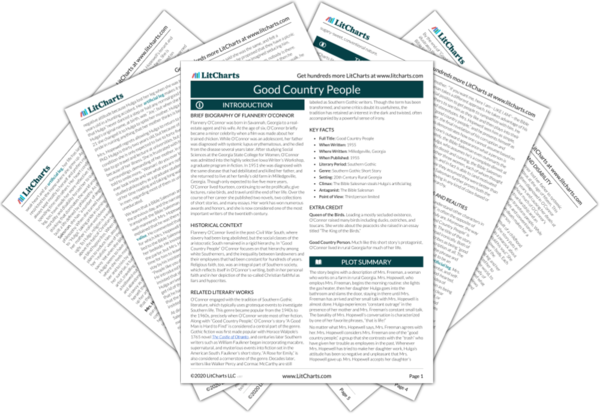Welcome to the LitCharts study guide on Flannery O’Connor's Good Country People. Created by the original team behind SparkNotes, LitCharts are the world's best literature guides.
Good Country People: Introduction
A concise biography of Flannery O’Connor plus historical and literary context for Good Country People.
Good Country People: Plot Summary
A quick-reference summary: Good Country People on a single page.
Good Country People: Detailed Summary & Analysis
In-depth summary and analysis of every of Good Country People. Visual theme-tracking, too.
Good Country People: Themes
Explanations, analysis, and visualizations of Good Country People's themes.
Good Country People: Quotes
Good Country People's important quotes, sortable by theme, character, or .
Good Country People: Characters
Description, analysis, and timelines for Good Country People's characters.
Good Country People: Symbols
Explanations of Good Country People's symbols, and tracking of where they appear.
Good Country People: Theme Wheel
An interactive data visualization of Good Country People's plot and themes.
Brief Biography of Flannery O’Connor
Flannery O’Connor was born in Savannah, Georgia to a real-estate agent and his wife. At the age of six, O’Connor briefly became a minor celebrity when a film was made about her trained chicken. While O’Connor was an adolescent, her father was diagnosed with systemic lupus erythematosus, and he died from the disease several years later. After studying Social Sciences at the Georgia State College for Women, O’Connor was admitted into the highly selective Iowa Writer’s Workshop, a graduate program in fiction. In 1951 she was diagnosed with the same disease that had debilitated and killed her father, and she returned to live at her family’s old farm in Milledgeville, Georgia. Though only expected to live five more years, O’Connor lived fourteen, continuing to write prolifically, give lectures, raise birds, and travel until the end of her life. Over the course of her career she published two novels, two collections of short stories, and many essays. Her work has won numerous awards and honors, and she is now considered one of the most important writers of the twentieth century.
Get the entire Good Country People LitChart as a printable PDF.

Historical Context of Good Country People
Flannery O’Connor lived in the post-Civil War South, where slavery had been long abolished, but the social classes of the aristocratic South remained in a rigid hierarchy. In “Good Country People” O’Connor focuses on that hierarchy among white Southerners, and the inequality between landowners and their employees that had been constant for hundreds of years. Religious faith, too, was an integral part of Southern society, which reflects itself in O’Connor’s writing, both in her personal faith and in her depiction of the so-called Christian faithful as liars and hypocrites.
Other Books Related to Good Country People
O’Connor engaged with the tradition of Southern Gothic literature, which typically uses grotesque events to investigate Southern life. This genre became popular from the 1940s to the 1960s, precisely when O’Connor wrote most of her fiction. Along with “Good Country People,” O’Connor’s story “A Good Man is Hard to Find” is considered a central part of the genre. Gothic fiction was first made popular with Horace Walpole’s 1765 novel The Castle of Otranto, and centuries later Southern writers such as William Faulkner began incorporating macabre, supernatural, and mysterious events into fiction set in the American South. Faulkner’s short story, “A Rose for Emily,” is also considered a cornerstone of the genre. Decades later, writers like Walker Percy and Cormac McCarthy are still labeled as Southern Gothic writers. Though the term has been transformed, and some critics doubt its usefulness, the tradition has retained an interest in the dark and twisted, often accompanied by a powerful sense of irony.
Key Facts about Good Country People
- Full Title: Good Country People
- When Written: 1955
- Where Written: Milledgeville, Georgia
- When Published: 1955
- Literary Period: Southern Gothic
- Genre: Southern Gothic Short Story
- Setting: 20th Century Rural Georgia
- Climax: The Bible Salesman steals Hulga’s artificial leg
- Antagonist: The Bible Salesman
- Point of View: Third person limited
Extra Credit for Good Country People
Queen of the Birds. Leading a mostly secluded existence, O’Connor raised many birds including ducks, ostriches, and toucans. She wrote about the peacocks she raised in an essay titled “The King of the Birds.”
Good Country Person. Much like this short story’s protagonist, O’Connor lived in rural Georgia for much of her life.












